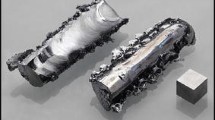Conclusions
-
1.
It has been established that molybdenum and tungsten borides oxidize during storage in air and generally contain a significant amount of oxides. A method is proposed for ridding molybdenum and tungsten borides of oxides, involving treatment with 2% hydrochloric acid and 1% oxalic acid, respectively.
-
2.
A study was made of the chemical stability of molybdenum and tungsten borides in some acids, mixtures of acids with oxidizing and complexing agents, oxidizing mixtures, and alkaline solutions.
Similar content being viewed by others
Literature cited
K. D. Modylevskaya and G. V. Samsonov, Ukr. Khim. Zh.,25, 55 (1959).
A. M. Vasserman, Yu. N. Surova, et al., Zavod. Lab.,34, No. 8, 919 (1968).
Author information
Authors and Affiliations
Additional information
Translated from Poroshkovaya Metallurgiya, No. 12 (108), pp. 54–57, December, 1971.
Rights and permissions
About this article
Cite this article
Kugai, L.N. Chemical stability of molybdenum and tungsten borides. Powder Metall Met Ceram 10, 982–984 (1971). https://doi.org/10.1007/BF00797362
Received:
Issue Date:
DOI: https://doi.org/10.1007/BF00797362




